Identify fungi on the go
Discover fungi when you're out and about with your own pocket-sized identification guide to the UK's common species.
Buy it now
Content manager, botanist and tree lover
Fungi are a huge and fascinating kingdom with over 15,000 species in the UK.
They live on land, in the water, in the air, and even in and on plants and animals. They vary widely in size and form, from the microscopically small to the largest organisms on Earth (at several square miles large).
Mushrooms (or toadstools) is a term given to the fleshy, spore-bearing fruiting bodies that certain fungi produce. Here are nine common mushrooms that you may come across.
Please be aware that fungi can be deadly poisonous – don’t use this blog to identify them for culinary use.
As a nation, we traditionally mistrust fungi. Our fears are amplified by old tales and folklore, coupled with their unearthly habits. They grow deep in the woods – in dark and damp places – and they seemingly magically appear on the dead or dying remains of other organisms. They often look bizarre and freakish, sometimes even resembling body parts from ears and brains to unmentionable others.
This is the earthstar you’re most likely to see in the UK.
Key features: collared earthstar looks at first like a small, brown bulb. The outer skin peels back into 4-8 pointed rays, covered in a fleshy layer. The fleshy layer cracks as the rays bend back and curl under, raising up the spore bag and leaving it sitting in a saucer-like base. The spores escape though a small, fringed opening, like a tiny beak, at the top. Up to 10cm across.
Where to look: among leaf litter in deciduous woods, especially with beech in chalky soils in the south. Late summer to autumn.
Unlike puffballs, which have a central opening in the top to ‘puff’ their spores, the common earthball’s scaly cap splits open to release spores.
Key features: rounded, dirty-yellow to ochre-brown, up to 10cm across. The thick, tough skin is covered in coarse warty scales. Inside, the spore mass is greyish, becoming purply-black marbled at first by white veins. Powdery when mature. They’re attached to the soil by cord-like threads. Has a rubbery smell.
Where to look: on mossy or peaty ground on heaths and in woodland, especially on sandy soil. Late summer to early winter.
This mushroom has been known to push its way through asphalt and lift the corners of paving stones. Its strength is down to the vertically-aligned hyphae in the stems.
Key features: fawn-grey conical cap that’s grooved and often split at the edges. Hollow white stem. Grows in tufts from buried decaying wood. Up to 17cm tall.
Where to look: pastures, parks and gardens, tree stumps and pavements - wherever there is buried wood. Common inkcap is very common and appears after rain. Spring to early winter.
Traditionally used as an insecticide, the cap was broken up and sprinkled into saucers of milk. Fly agaric is now known to contain ibotenic acid, which both attracts and kills flies.
Key features: probably our most familiar toadstool, with a brilliant scarlet or orange cap covered with white, wart-like spots. Underneath the cap, the gills are white. The white stem has a floppy ring and a bulbous base surrounded by fleecy bands. Up to 20cm across and 30cm tall.
Where to look: on light soils in mixed woodland and heaths among birch, pine and spruce. Late summer to the first frosts of winter.
This species is also known as warted puffball, gem-studded puffball or the devil's snuff-box.
Key features: upturned pear-shape that usually grows to 3 – 6 cm across and 4 – 9cm tall. It has tiny pearl-like dots covering the outer surface. Common puffballs are initially white later turning yellow, olive or brown with age. When mature, the spores escape through a hole in the top. Often grows in groups.
Where to look: grows on the ground in leaf litter in woodland and pasture. Summer to late autumn.
Its Latin name, translated as ‘Jew’s ear’, comes from the legend that Judas hanged himself on an elder tree after betraying Jesus.
Key features: at first cup-shaped, developing lobes that make them look uncannily like human ears. Tan-brown and velvety on the outside, with a wrinkled shiny inner surface. Rubbery, gelatinous flesh. Up to 8cm across.
Where to look: usually in clusters, drooping from dead and dying branches, mainly of elder. Jelly ear can be seen all year round, especially during spells or wet weather.
Also known as fairies’ baths, scarlet elf cups make a tiny puffing sound when they release their spores into the air. They are more common in the wetter west side of the UK.
Key features: Cup shaped to saucer shaped, up to 4cm across. The upper surface is a brilliant scarlet red, fading with age to orange. The underside is paler and downy. Attached by a little stalk.
Where to look: on decaying sticks and branches buried in leaf litter or moss in damp places on the woodland floor. Also can be seen on the sides of ditches and stream banks. Early winter to early spring.
Recognisable by its foul odour, the stinkhorn relies on flies and other insects to transport its spores. The slime on its cap is a sticky mass of spores that has a sickly sweet rotting-flesh smell to attract insects.
Key features: first appears like a white egg nestling in leaf litter and moss. A thick white polystyrene-like stem emerges from the egg. Has a conical slimy olive-green cap. The cap is crowned by a small white ring. Grows up to 25cm tall. Smells like rotting flesh.
Where to look: in woodland and gardens. More often smelled than seen, its aroma can be detected far and wide and can be mistaken for dead animals or bad drains. Summer to late autumn.
Its scientific name rhacodes comes from the Greek word rhakos, which means a piece of cloth. It does often have a soft, ragged fabric-like appearance.
Key features: the cap is at first egg-shaped and chestnut-brown, then opens flat and the outer skin breaks up into shaggy brown scales on a cream background. Underneath the cap the gills are creamy-white, bruising red. The stem is bulbous at the base and has a double ring that can be moved up and down. Shaggy parasol smells sweetly aromatic. Up to 20cm tall and 15cm across.
Where to look: in woods and shrubberies, often with conifers. Summer to late autumn.
Discover fungi when you're out and about with your own pocket-sized identification guide to the UK's common species.
Buy it now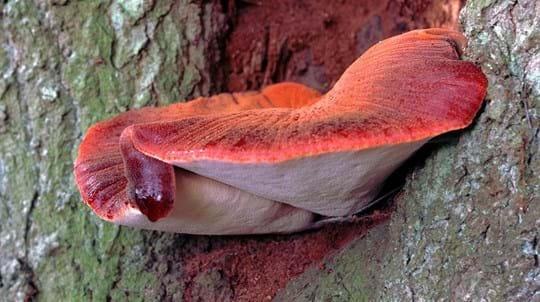
Blog
Helen Keating • 29 Oct 2018
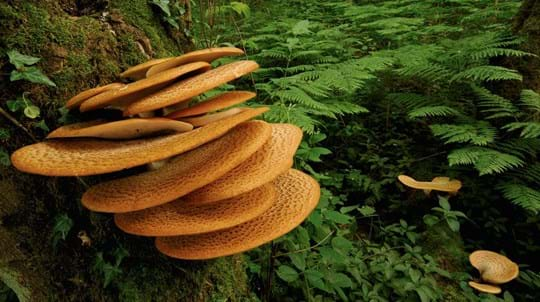
Blog
Amy Lewis • 21 Oct 2021
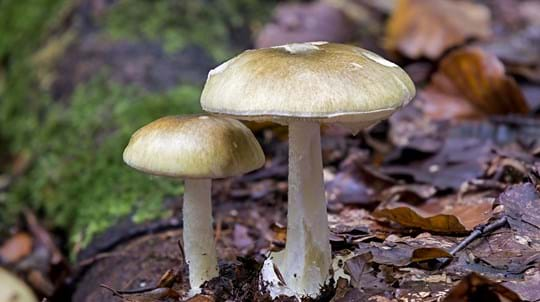
Blog
Helen Keating • 27 Oct 2022
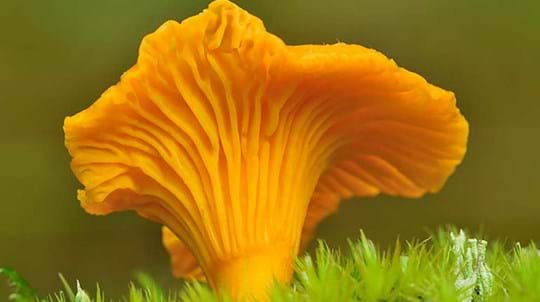
Trees woods and wildlife
A dazzling array of shapes, sizes and colours. Find out about fungi and lichens, from ancient taboos to magic and medicine.
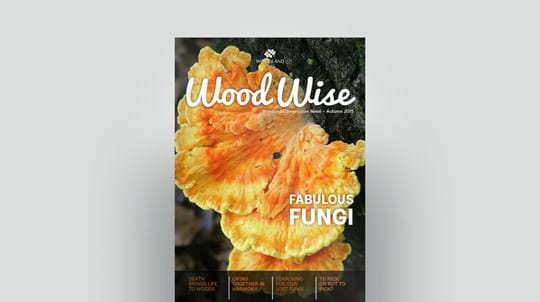
Journal
PDF (1.58 MB)
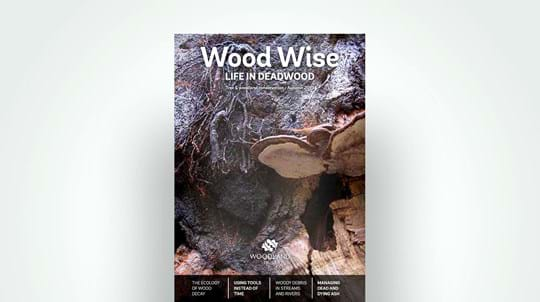
Journal
PDF (4.01 MB)